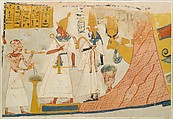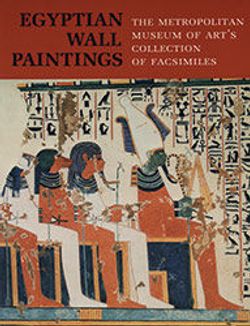Deceased censing and libating to the deified Mentuhotep and Ahmose-Nefertari, with the Hathor cow emerging from the mountain; Tomb of Ameneminet
New Kingdom, Ramesside
Not on view
Between 1907 and 1938, under the leadership of British Egyptologist Norman de Garis Davies, the Graphic Section of the Museum’s Egyptian Expedition undertook a documentation project with the goal of recording ancient monuments as accurately as possible.
This facsimile copies a small scene painted in the northwest corner of the tomb chapel of Ameneminet (Theban tomb no. 277). Located in the Qurnet Murai necropolis, this small rock-cut tomb was made for a priest serving in the mortuary temple of King Amenhotep III, probably during the course of Dynasty 20.
Ameneminet is depicted on the left, pouring a libation and censing in front of King Mentuhotep II and Queen Ahmose-Nefertari. Beyond, in the Theban mountain, is the cow goddess Hathor. Mentuhotep II and Ahmose-Nefertari are shown posthumously, not as living beings but as images, as suggested by the rectangular pedestal beneath Mentuhotep II’s feet and Ahmose-Nefertari’s dark complexion. Ahmose-Nefertari’s posthumous representations often show her with black skin. In ancient Egypt the color black evoked rebirth and regeneration, in connection with the fertile black soil brought by the Nile inundation. The dark complexion refers to the deified status Ahmose-Nefertari acquired after her death. As the wife of King Ahmose, founder of a new dynasty (Dynasty 18), and mother of Amenhotep I, she may have been seen as the matriarch of the entire dynastic line and in some ways she embodied the idea of regeneration.
This scene is set in the well-defined locality of Western Thebes. This setting is evoked by the presence of King Nebhepetre-Mentuhotep II, who descended from a family of Theban rulers and built his tomb and mortuary temple at Deir el-Bahri; Ahmose-Nefertari, who, with her son Amenhotep I, became the patron deity of the artistic community of Deir el-Medina; the cow goddess Hathor, who was worshipped in the Theban area as early as Dynasty 12; and the Theban mountain that was part of the mountain range preceding the desert plateaus on the west bank of the Nile river.
This image cannot be enlarged, viewed at full screen, or downloaded.


